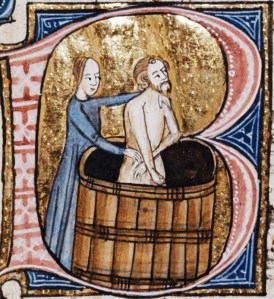It is pretty commonly known that medieval times would have been full of unpleasant smells, including but not limited to body odor. There are some historical accounts of people bathing only once or twice a year, yet others that say it was a weekly, or at least regular, practice.
There seems to be no dispute that daily washing of the hands and face was common. Even though medieval physicians hadn’t quite linked specific diseases with poor hygiene, (and didn’t thoroughly begin to question that until after the Black Death ravaged Europe) they were starting to understand that dirt and filth should be washed away.
Still, there were certain barriers to bathing, some practical, others rooted in medieval belief systems. It was a subject fraught with uncertainty in terms of both health and morality, and was only recommended at certain times of the year. In summer, when we would think people must be at their dirtiest between the heat and field work, baths were to be avoided because of the belief that certain humours governed the body. In summer’s case, the humour choler (hot and dry).
 The Secretum Secretorum advised against anything heating in summer (including baths), saying that “through all the seasons of the year one must cure contraries with contraries.” This same medical treatise devotes an entire section to bathing, and warns that “excessively long baths lead to fatness and feebleness.” Other health manuals of the day use bathing as a prescription to cure specific conditions, viewing it more as a treatment than a simple cleanliness routine. Another common belief was that water could carry disease—a belief with some validity considering water was not treated then as it is now. The line of thought was that hot water opened the pores, allowing disease to access the body through the skin, not only from the water itself, but even after the bath by “infections on the air.”
The Secretum Secretorum advised against anything heating in summer (including baths), saying that “through all the seasons of the year one must cure contraries with contraries.” This same medical treatise devotes an entire section to bathing, and warns that “excessively long baths lead to fatness and feebleness.” Other health manuals of the day use bathing as a prescription to cure specific conditions, viewing it more as a treatment than a simple cleanliness routine. Another common belief was that water could carry disease—a belief with some validity considering water was not treated then as it is now. The line of thought was that hot water opened the pores, allowing disease to access the body through the skin, not only from the water itself, but even after the bath by “infections on the air.”
Moral objections to bathing came from the Church, which over time added more and more restrictions, including the prohibition of bathing without clothes. These restrictions were largely a reaction to the problems of public bathing, which led to “immorality, promiscuous sex, and diseases.” Public bath houses, which had been around since even before Roman times, were indeed often places where questionable behavior took place—particularly those where men and women bathed together. Some bath houses were little more than fronts for brothels.
Private bathing was a different matter. The poor rarely had the time or means for a full bath, which involved the laborious task of carrying and heating water by the bucketful to fill a wooden tub. Bathing at home for a peasant would typically be little more than washing off parts of the body with a rag and a basin of cold water. For the wealthy (including wealthy monasteries), bathing was far more common. While some royals claimed to avoid it for moral reasons, others were known to indulge frequently, even making bathing a form of entertainment for guests. Large wooden tubs would be lined with either thick cloth or sponges so there would be something soft to sit on. They would be tented for privacy, and filled with warm water by servants. Bath water might also be infused with pleasant smelling herbs.
In lieu of bathing for those who either feared its dangers, or had moral objections, the body might be rubbed with scented rags or its odors masked with strong perfumes. Men sometimes wore a bag of fragrant herbs beneath the shirt, and women applied scented powders.
Reblogged this on The Weaving Word.
LikeLiked by 1 person
Reblogged this on Chris The Story Reading Ape's Blog and commented:
Information not to be sniffed at? 😄🐵
LikeLiked by 1 person
I’ve often thought that one sign of civilization is the availability of hot running water.
LikeLiked by 2 people
Reblogged this on The Scholarly Scribe.
LikeLiked by 1 person
This makes me think of King John and his frequent baths. 🙂 In his case, though, I think it was another indication of his extravagance (and possibly his paranoia?).
LikeLiked by 2 people
Very interesting!
LikeLiked by 1 person
Reblogged this on England's History.
LikeLiked by 2 people